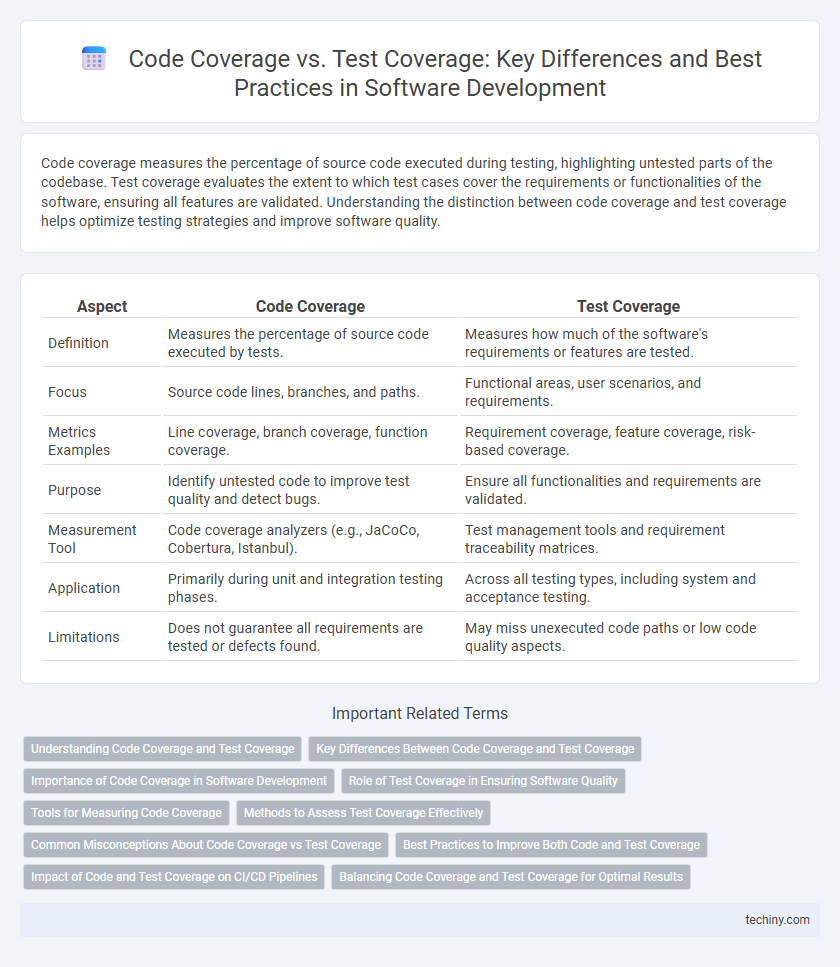Code coverage measures the percentage of source code executed during testing, highlighting untested parts of the codebase. Test coverage evaluates the extent to which test cases cover the requirements or functionalities of the software, ensuring all features are validated. Understanding the distinction between code coverage and test coverage helps optimize testing strategies and improve software quality.
Table of Comparison
| Aspect | Code Coverage | Test Coverage |
|---|---|---|
| Definition | Measures the percentage of source code executed by tests. | Measures how much of the software's requirements or features are tested. |
| Focus | Source code lines, branches, and paths. | Functional areas, user scenarios, and requirements. |
| Metrics Examples | Line coverage, branch coverage, function coverage. | Requirement coverage, feature coverage, risk-based coverage. |
| Purpose | Identify untested code to improve test quality and detect bugs. | Ensure all functionalities and requirements are validated. |
| Measurement Tool | Code coverage analyzers (e.g., JaCoCo, Cobertura, Istanbul). | Test management tools and requirement traceability matrices. |
| Application | Primarily during unit and integration testing phases. | Across all testing types, including system and acceptance testing. |
| Limitations | Does not guarantee all requirements are tested or defects found. | May miss unexecuted code paths or low code quality aspects. |
Understanding Code Coverage and Test Coverage
Code coverage measures the percentage of source code executed during automated testing, highlighting untested parts and potential bugs. Test coverage evaluates the extent to which test cases cover software requirements or functionalities, ensuring comprehensive validation of features. Understanding both metrics helps optimize testing strategies, improve software quality, and reduce risks in software development projects.
Key Differences Between Code Coverage and Test Coverage
Code coverage measures the percentage of source code executed during testing, focusing on which lines, branches, or functions are tested to identify untested parts of the application. Test coverage assesses the breadth and depth of the testing process itself, including the range of requirements, features, or user scenarios validated by test cases. Key differences lie in code coverage's emphasis on code execution paths, while test coverage encompasses the overall effectiveness of test cases in meeting functional and non-functional requirements.
Importance of Code Coverage in Software Development
Code coverage measures the percentage of source code executed during testing, providing crucial visibility into untested paths that might harbor defects. High code coverage ensures that most code branches are examined, reducing the risk of undetected errors and improving software reliability. Emphasizing code coverage in software development enhances test quality, facilitates maintainability, and supports continuous integration practices.
Role of Test Coverage in Ensuring Software Quality
Test coverage measures the extent to which test cases exercise the software's functional requirements, ensuring critical paths and features are verified against expected behaviors. It plays a pivotal role in identifying untested parts of the application, reducing risks of defects and software failures in production. Comprehensive test coverage enhances software quality by validating business logic, improving reliability, and supporting maintainability through systematic testing of edge cases and integration points.
Tools for Measuring Code Coverage
Popular tools for measuring code coverage include JaCoCo, Cobertura, and Istanbul, which provide detailed reports on the percentage of code executed during testing. These tools integrate with continuous integration pipelines and support multiple programming languages, enabling developers to identify untested code segments efficiently. Accurate code coverage metrics help improve test suites and ensure software quality by revealing gaps that might lead to defects.
Methods to Assess Test Coverage Effectively
Effective methods to assess test coverage include analyzing code coverage through tools that measure the percentage of source code executed during testing, focusing on statement, branch, and path coverage. Combining code coverage metrics with requirement-based test coverage helps ensure that all functional aspects and user scenarios are validated. Employing coverage reports alongside mutation testing enhances the thoroughness of tests by identifying untested code paths and improving overall software quality.
Common Misconceptions About Code Coverage vs Test Coverage
Code coverage measures the percentage of code executed during testing, while test coverage assesses the range of test scenarios or requirements validated by the tests. A common misconception is that high code coverage guarantees software quality, but in reality, comprehensive test coverage better ensures functional correctness and defect detection. Relying solely on code coverage can lead to missing critical edge cases that thorough test coverage aims to identify.
Best Practices to Improve Both Code and Test Coverage
Improving both code coverage and test coverage requires implementing comprehensive automated testing strategies including unit, integration, and end-to-end tests to ensure all code paths are evaluated. Employing continuous integration tools with coverage reporting enables early detection of under-tested areas, guiding targeted test development. Maintaining clear and maintainable test cases with proper mocking and stubbing practices helps to achieve accurate coverage metrics while reducing false positives.
Impact of Code and Test Coverage on CI/CD Pipelines
Code coverage measures the percentage of source code executed by automated tests, whereas test coverage assesses the extent of testing across all functional requirements. High code coverage enhances the reliability of CI/CD pipelines by ensuring that potential bugs are identified early, reducing deployment risks. Comprehensive test coverage validates application behavior under diverse scenarios, improving the confidence and stability of continuous integration and delivery processes.
Balancing Code Coverage and Test Coverage for Optimal Results
Balancing code coverage and test coverage ensures comprehensive software quality by measuring both the proportion of code executed by tests and the variety of test scenarios evaluated. High code coverage alone may not reveal untested edge cases, while extensive test coverage without sufficient code coverage risks missing critical execution paths. Optimal results arise from integrating thorough code execution metrics with diverse test case design, improving defect detection and fostering robust, maintainable software.
Code Coverage vs Test Coverage Infographic

 techiny.com
techiny.com